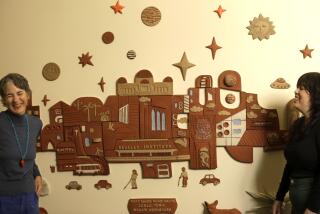TARZANA : Group Gives Blind Readers a Helping Hand
- Share via
It all began in Jean Norris’ kitchen more than 35 years ago when Norris was looking for a way for blind parents to read to their sighted children and vice versa.
It has grown into the nonprofit American Action Fund for Blind Children and Adults, which is housed in a 7,000-square-foot building in Tarzana. The fund produces books, calendars and a newspaper for the blind.
As Norris tells it, in 1958 she met a blind mother whose sighted children couldn’t understand why she couldn’t read to them. In her kitchen, Norris took the children’s books apart, added Braille text on separate pages and then re-bound the pages into books consisting of alternating Braille and printed pages.
That way, sighted and blind people could read the books together. Norris named the finished product Twin Vision Books.
From books, the mainly volunteer organization went on to produce a Braille newspaper and Braille calendars that are sent to subscribers throughout the world.
In 1964, Norris, with the help of volunteer transcribers, began to publish Hotline for the Deaf-Blind. The Braille newspaper is sent to the deaf-blind in the United States and 40 foreign countries.
The first Braille calendars printed by Norris’ group were intended as Christmas presents, but many other blind people began requesting the 6 1/2-by-6-inch calendars.
“In 1965, the only Braille calendars available were big and bulky and contained philosophy and religious things,” Norris said.
Today, her group produces about 30,000 calendars a year.
Although the organization’s library is computerized and there are four state-of-the-art Braille presses, the bulk of the transcribing for the books is still done by volunteers working at home with Braille machines.
Norris said that more than 100 volunteer transcribers receive printed books by mail, transcribe them into Braille and return the finished pages to be bound. The Braille translations remain as close to the originals as possible, she said.
Among the books produced by Norris’ group is a series with raised illustrations, such as “The Wonderful World of Trees,” which allows blind children to picture the images. Another example features raised images of dinosaurs.
About 500 copies of each illustrated book are produced, and copies are sent to every school for the blind in the United States as well as regional lending libraries. Schools often use the American Action Fund library as a resource for blind children, particularly for supplemental reading materials.
Norris said the organization conducts tours at its facility and is supported by donations of books as well as cash gifts.
More to Read
Sign up for our Book Club newsletter
Get the latest news, events and more from the Los Angeles Times Book Club, and help us get L.A. reading and talking.
You may occasionally receive promotional content from the Los Angeles Times.










